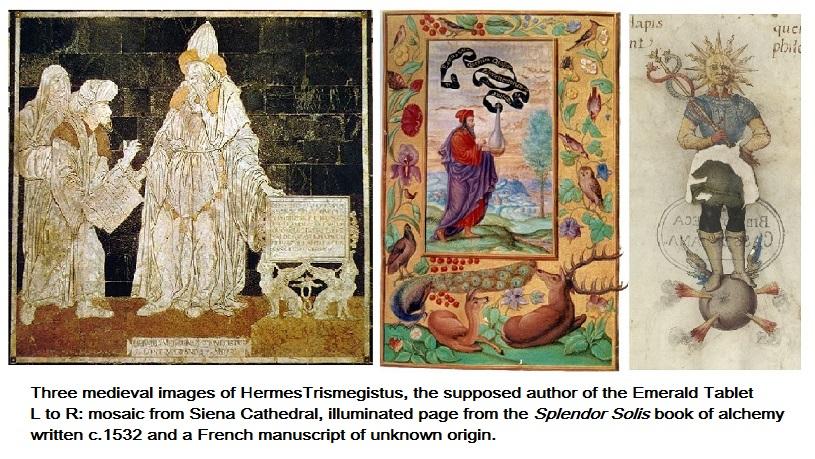GREEN & GOLD – THE EMERALD TABLET AND THE ORIGINS OF EUROPEAN ALCHEMY
Alchemy is an extremely broad term that covers a range of pseudo philosophical-scientific traditions from around the world but at its heart is the idea that mere men can manipulate matter to create magical substances. The list of these fabled potions and elixirs included a universal solvent to dissolve everything (which begs the question in what would you keep it!), a universal medicine to cure all ills and, most famously, something that would transmute base metal into gold.
In European alchemy, it was believed that the key to all these wonders lay in finding the ‘philosophers’ stone’ and the search for this mysterious ingredient was named the Magnum Opus (great work). All the great alchemists of the Middle Ages were engaged in the Magnum Opus and most began their studies by investigating the legendary Emerald Tablet.
Despite its reputation for being the fountain of all arcane knowledge, the ‘wisdom’ of the Emerald Tablet, which is also known as the Tabula Smaragdina, is contained in just 14 apparently meaningless maxims. Over the centuries these riddles have been translated and re-translated many times in an attempt to uncover their secrets but no one yet has produced a credible solution to the apparent mystery. So where did this nonsensical, yet highly influential, piece of prose originate?
It is highly unlikely that an actual stone tablet ever existed and the origin of the riddles themselves are shrouded in legend. The author named in the text, Hermes Trismegistus (thrice blessed), is actually a composite god of wisdom that combines elements of the ancient Greek Hermes with the ibis-headed, Egyptian deity Thoth. Yet, in spite of The Tablet’s claim to great antiquity and divine authorship, the text was written, by human hands, sometime at the end of the Classical Period.
The earliest recorded version of the text appears in an 8th Century Arabic treatise on alchemy called the 'Kitab sirr al-ḫaliqa' (the Book of Creation’s Secrets & the Arts of Nature) written by a man named Balinas who is also known as ‘Pseudo-Apollonius of Tyana’. Balinas claimed that he had found a secret chamber beneath a ruined Temple of Hermes which contained a golden throne. Upon this throne was seated a mummified corpse, and in its desiccated hands was the Emerald Tablet.
Balinas’ story appears in several works by other Arab alchemists and was first translated into Latin by Hugo of Santalla, a 12th Century Spanish monk who wrote a number of books on magic. Four hundred years later, the riddles appeared in printed form in the ‘Chrysogonus Polydorus’ published in Nuremberg in 1541.
Medieval Alchemists believed that The Tablet’s riddles were a coded recipe for creating the philosopher’s stone but Renaissance magicians, such as John Dee and Cornelius Agrippa, thought that studying The Tablet would reveal the true nature of God. During the 18th Century, The Tablet even attracted the attention of Isaac Newton whose own attempt to decipher the code is now kept the library of King’s College at the University of Cambridge.
Unlike the laws of planetary motion, Newton failed to unravel the meaning (if any!) of the Emerald Tablet but if you think you can succeed where the great scientist failed, here is Newton’s translation:
1. Tis true without error, certain and most true.
2. That which is below is like that which is above and that which is above is like that which is below to do the miracles of one only thing.
3. And as all things have been and arose from one by the mediation of one: so all things have their birth from this one thing by adaptation.
4. The Sun is its father, the moon its mother, the wind hath carried it in its belly, the earth is its nurse.
5. The father of all perfection in the whole world is here.
6. Its force or power is entire if it be converted into earth.
7. Separate thou the earth from the fire, the subtle from the gross sweetly with great industry.
8. It ascends from the earth to the heaven & again it descends to the earth & receives the force of things superior & inferior.
9. By this means you shall have the glory of the whole world
10. And thereby all obscurity shall fly from you.
11. Its force is above all force. For it vanquishes every subtle thing and penetrates every solid thing.
12. So was the world created.
13. From this are and do come admirable adaptations whereof the means, or process, is here in this. Hence I am called Hermes Trismegistus, having the three parts of the philosophy of the whole world.
14. That which I have said of the operation of the Sun is accomplished and ended.
To read ‘Thomas and the Necromancer’, my short story featuring medieval magic click here
